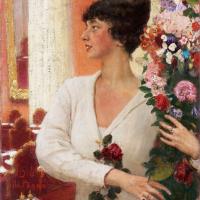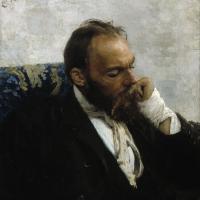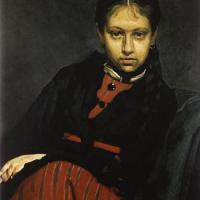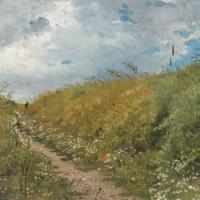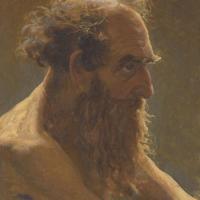Ilya Repin
Portrait Of M. P. Musorgsky
$480.00
Portrait Of Professor Ivanov
$480.00
Portrait Of Vera Shevtsova
$480.00
Road Through A Dell
$450.00
They Did Not Expect Him
$540.00
Ukrainian Girl
$480.00
What Freedom
$480.00
Ilya Repin
Ilya Repin (1844-1930)
Ilia Iefimovich Repin is a Russian painter born on July 24, 1844 (5 August in the Gregorian calendar ) and died onSeptember 29, 1930 in Kuokkala ( Finland ).
Repin was born in Tchouhouïv , near Kharkiv (at that time in the Russian Empire , today in Ukraine ). His parents trade in horses, his father is a former Cossacksoldier and his mother runs a small rural school. He worked in his youth as an icon painter, studied drawing with Ivan Kramskoi , and continued his training at the Imperial Academy of Fine Arts .
In 1878 he became a member of the itinerants (a group of realistic painters), and was later appointed Academician of the Imperial Academy of Fine Arts . Professor, workshop master (1894-1907) then rector (1898-1899) of the academy, teacher at the school of arts and crafts of Maria Tenicheva , he has among his students Boris Kustodiev , Igor Grabar , Ivan Kulikov , Philippe Maliavine , Anna Ostroumova-Lebedeva and Nikolai Fechine . He is also the master of studies of Valentin Serov .
From the beginning of his creative activity, in the 1870s, Repin became one of the key figures of Russian realism . He succeeds in reflecting in his pictorial production the diversity of the life that surrounds him, to embrace in his work all the dimensions of contemporaneity, to approach the themes that cross the society and to react strongly to the actuality. His pictorial language has a plasticity that is personal to him, and he appropriates different styles, from the Spanish and Dutch painters of the xvii th century to those of Alexander Ivanov , as well as elements Impressionist French who are contemporary to him, but he has never worshiped.
The work of Répine flourished in the 1880s. He then composed a portrait gallery of his contemporaries, worked as a painter of history and genre scenes . In historical painting, he is attracted by the possibility of expressing the emotional force of the represented scene. He also finds his inspiration in the painting of contemporary society, and even when he depicts a legendary past, he remains a master of the representation of the immediate, abolishing any distance between the spectator and the heroes of his work. .
According to Vladimir Stassov , Repin's work is thus an "encyclopedia of Russia after the abolition of serfdom" . He spent the last 30 years of his life in Finland on his Penate property in Kuokkala . He continues to work there, although less intensely than before. He writes memoirs, some of which are published in the memory book (far and near) .
Kornei Chukovsky recounts in his essays his first encounter with Repinus in Kuokkala : the painter, whose canvases struck by their size, was not an imposing giant: "small, smiling, stocky, with a tanned face, always the same old knitted gloves ". Yakov Mintchenkov, after having frequented the painter at the time of the preparation of the 1898 exhibition of the Ambulants, remembers having had before him a small, dry man, with curly hair and a pointed beard. The recognized master, whose appearances were expected, was of a "modest modesty" , behind which was hidden "playfulness of a child spoiled by fate".
But he was invested in friendly and social relations; the niece of Repin's first wife, Lioudmila Chevtsova-Spore, who had lived in the painter's Petersburg apartment for three years, confided that the guests came and went constantly in the open house of Ilia Iefimovitch: apart from other painters, his regulars were the writers Maxime Gorky and Zinaida Hippius , the artists Grigori Gay , Vladimir Maksimov , the scholars Dmitry Mendeleyev and Vladimir Bekhterev . In addition, in this period, three wards of his studio lived in this vast apartment, including his favorite student, Constantin Veshchilov . These pupils followed him in the summer months, when the painter was going to Zdravnevo.
After moving to the Penate property in 1900 , she was forced to adopt a less open lifestyle. He continued his relations with those who previously surrounded him by corresponding with them. Every day the postman brought many letters to the painter, and he answered each one himself, spending several hours there. In the same way, he was obliged to read daily newspapers. Any book brought to Kuokkala made for him event. His letters to his friends abound in literary details: "I reread Korolenko . What a great thing that his Shadows " , " read aloud Nekrasov to the people - what a pleasure ".
Repin exposed the principles of his work in the pages of his book Far and Near and in particular in The Matter, as such : "It is not my business that beauty, Touch or the virtuosity of the brush, I have always pursued the essential: the body, as a body ". He refuses the "acrobatics of the brush, the painting for painting" , and he is ready to repeat after Ivan Kramskoi that "the most precious quality of a painter is the heart".
He describes his realistic style of "popular" , noting that attempts to copy it never succeeded: his brush stroke, according Qurie Chukovsky, is "truly his own".
The painter, when working on portraits, recognizes himself "to fall for a short time" from his model, to study the books of the writers he represents, to listen to the music of the composers, to recite by heart long extracts poetry verses. It is not long, but like a "honeymoon" forced with those he creates an image. Thus, working with the Boatmen of the Volga , Ilia Iefimovitch is delighted with Kanine, "falls in love with each of the traits of his character, of each of the nuances of his skin and his hemp shirt" ; researchers see its passionate nature as a "professional rationality". Although he also draws and draws in watercolor and ink, he favors oil colors.



